“Right tool for the right job” doesn’t apply anymore.

Tools of the trade for mixed reality envisioning include VR headsets
Ingenuity
The type of envisioning we’re doing requires quite the diverse toolset – some of which haven’t even been invented yet. That’s where you come in. One of the ideas you’re chasing down may need a new kind of tool to be fabricated right on the spot. Some ingenuity is required.
Every day brings inspiring examples of people figuring out how to use existing tools for completely new reasons in this field. Some of them are fairly complicated, like leveraging VR motion controllers as camera trackers for video compositing (probably not the inventor’s original intention) or creating a whole new software tool from scratch just to help designers prototype the placement, scale, and manipulation of items.
Other times we’ll be using tried and true old friends in completely new ways. Who thought PowerPoint would be so useful animating holographic scenes quickly? Did anyone see the voice recorder app on your phone as the best way to get your narrative down?
The search for new ways to create will have us regularly checking into tools that we’ve only heard about in passing. Needing to find a specialized tool for just part of scenario is situation normal. Downloading, trying, and discarding trials of things happens pretty regularly, too. It’s all part of being willing to try out ideas regardless of what needs to be learned along the journey.
Just like the toolset, our traditional roles as people on the team are expanded, blown apart, and recombined in new ways. Developers are sketching things out regularly. Designers create interactive prototypes by coding. Storytellers embrace new methods that combine both technology and personal interaction. There are no hard lines that separate our disciplines in mixed reality. We are all who we need to be at that particular moment to move things along.
By now it must be apparent that exploring and creating for this brave new world of mixed reality means we’ll all be uncomfortable at points because we just plain don’t know how to get to the end. And honestly, that’s the fun of it.
Design Tools
There are a handful of digital design tools that just about every designer uses – Photoshop, Illustrator, and After Effects. If you’re into 3D, throw in Maya or Cinema 4D. Mobile? Sketch, right. All of these tools and many more augment our natural ability to visualize, draw, model, paint, and generally be crafty with our hands and minds. We have become so comfortable using them in particular ways they often become the basis for most of what we do design-wise each day.
That’s about to change.
Envisioning for mixed reality is all about your ability to blend convincing digital holograms into the world. There’s no app for that. We have to come up with ways of combining existing features of several different tools together to synthesize these visions. There’s literally no blueprint for how to do this well. Embrace the fun of discovering how to accomplish these new effects, not how fast or easily they come. You’ll be surprised at how many novel ways of getting things to work pop into your head when you’re in it for the ride.
Here are a few tools to consider combining with others to create a new playbook and tool palette for your mixed reality work.
Paint 3D

Microsoft Paint 3D is a great intro to 3D and terrifically useful in prototyping
In a pleasant throwback UI surprise, Paint 3D offers a pro-active training overlay to get novices into 3D very quickly by previewing what the basic widgets do. The focus is clearly on the creator new to 3D, but the app delivers the goods for experts, too. The ability to export to a 3D model in geometry format for use in Unity and other composition programs is a huge plus. Fast in, fast out. The rendering and shading of objects is way better than you’d think for an app like this.
SUPERPOWER – Paint 3D is an incredibly useful tool for quick creation of placeholder holograms and composition of the scene to be translated in the real world. No device required. And the ability to paint directly on a 3D object is just crazy for a seemingly simple tool like this.
HoloSketch

HoloSketch excels at the composition part of prototyping (source: Microsoft)
The ability to compose a scene is just one step in the prototyping process, but it’s a critical one. Ask any filmmaker about what makes a scene memorable, and beside the emotional aspect of the dialogue and interaction, the placement and relative positioning of elements in the scene makes a huge difference in the impact for the viewer. HoloSketch gives you a straightforward way to try out many iterations of your ideas.
SUPERPOWER – HoloSketch gives you the ability to easily import and place holograms in-device. Nothing beats the ability to quickly holographic placeholders within the physical world.
Unity
Without question, the most useful all-around tool for working in mixed reality is Unity . This constantly improving tool allows designers and developers to create, compose, and test out their mixed reality ideas with real models and code within an integrated development environment (IDE) . Formerly considered a more technical tool for multi-platform game development, Unity is now very approachable tool for anyone to do simple modeling, 3D scene composition, wiring up interactivity, and applying incredible special effects.
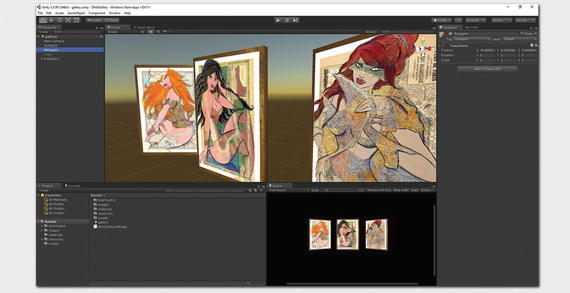
Unity gives anyone a straightforward way to get from idea to working code
Designers have often loathed the prospect of learning true 3D modelers and animation systems, not to mention development environments. Although Unity is all of those things, the benefits of diving in and leveraging it get real with your ideas far outweighs any effort overcoming the slight learning curve. It’s also built to support a very interactive and fluid workflow. Trust, me, Unity is your best friend for prototyping and turning your envisioning work into real projects.
SUPERPOWER – Unity is a one stop shop for everything mixed reality. This must have tool enables you to go all the way from idea to modeling, composition, adding object interactivity, previewing behavior, and finally preparing a project for on-device deployment.
Adobe Audition
Sound is the most overlooked aspect of mixed reality experiences (initially). Once you realize how impactful the right sounds and ambient soundtrack have on the overall experience you will automatically start figuring out where to incorporate them. That’s where Adobe Audition comes in.
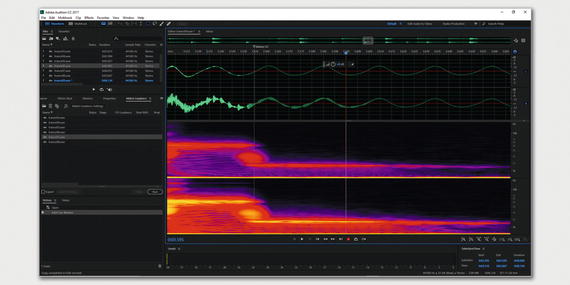
Adobe Audition delivers what you’ll need for audio design
Audio software and 3D modeling software are among the most complex and scary looking software humans have ever produced. Don’t let that dissuade you from jumping in and learning just enough about the basics to get some great use out of this pro quality tool. Coming up with just the right sound for your ambient environment, individual interactions with holograms, and interface cues can all make the difference between a good app and a breakthrough experience.
Adobe Audition is just one of the many sound creation and editing apps you could use to record and manipulate sound – its key benefit being its high quality and comes included with an Adobe Creative Cloud suite subscription.
SUPERPOWER – every sound-related function available to you in one place with Audition. Sound is so important to the overall holographic experience that learning how to leverage the power here is a real advantage to the envisioneer.
Mental Canvas
The first time you see a 3D sketching app at work you realize it’s completely natural, obvious, and one of those things that you could even imagine existing for real. Mental Canvas is a giant leap forward for sketching and an absolute wonder to use. Using a standard digital sketchbook metaphor, Mental Canvas brings an innovative set of functionalities to the task of sketching out scenes – the ability to zoom through the 3D space that your sketch exists in.
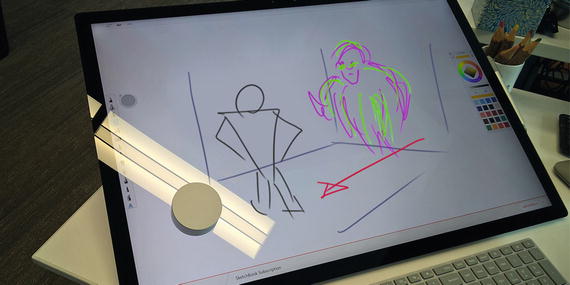
Mental Canvas brings a third dimension to sketching using the Surface Dial and Pen
The combination of the Dial, Pen, and Surface touchscreen creates the perfect storm of productivity for the drawing crowd. There’s never been anything quite like this available to artists and designers to add depth to scenes in such a natural way. Huge advance.
SUPERPOWER – being able to zoom through space to examine different areas of your holographic idea sketch is ground-breaking and incredibly useful during rapid ideation. This setup allows you to move through the scene in early sketch form to convey key elements.
Photoshop and Illustrator
Unlike many other areas of production design, you shouldn’t reach for these workhorse tools first. Using Adobe Photoshop or Adobe Illustrator would mean you’re probably thinking of locking in to high-fidelity comps of your ideas in 2D, which is fine, but not the optimal path to fully immerse yourself for mixed reality. Once you get going with other techniques, these tools are great for compositing static elements together into comps to share with people, creating storyboard frames, or doing some conceptual illustrations.

Adobe Photoshop and Adobe Illustrator are your best choice for 2D asset creation
These incredibly deep tools also come in handy to create just any kind of visual asset imaginable for our prototypes ahead of time so that part of our process flows more smoothly. There are other apps that do this same kind of creation and editing, but none are used more widely, and have more online tutorials walking you through amazing techniques step-by-step.
SUPERPOWER – same as always, Adobe Photoshop and Adobe Illustrator are the best at what they do. They are highly reliable tools to help produce the critical parts of our digital assets.
Development Tools
When envisioning your projects, there will be times when you have to build out the prototype as working code. No getting around that. Perhaps it’s because you need to do a technical proof of some innovative feature, or it’s important to test out a theory about how things could work on-device. Sometimes it you may even need to hookup peripherals, sensors, or other pieces of hardware to get a working prototype together. Regardless, there are only a few programming editors and professional environments people universally trust to be solid and up to managing anything from quick one-offs to hugely complex projects. In these early days of envisioning, anything goes, but I’d suggest giving yourself a solid head start by using these proven toolsets.
Visual Studio
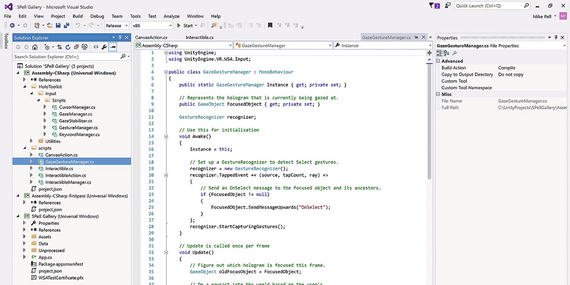
Microsoft Visual Studio is an industrial-strength development tool for mixed reality
The incredible flexibility, extensibility, and accessibility of Visual Studio lends itself well to being a foundational part of this evolving platform. As new libraries and SDKs come online for mixed reality, you can be they’ll be available within Visual Studio first.
SUPERPOWER – Visual Studio has always been known for its world-class debugging tools, whether using an emulator or remotely on device. IntelliSense rules.
Apple Xcode
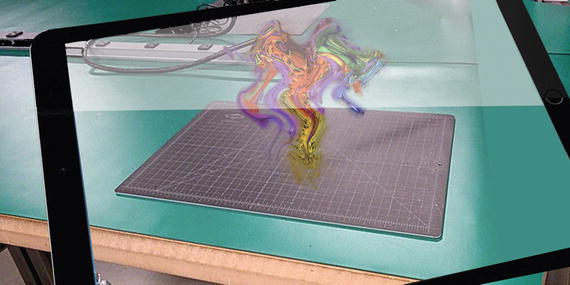
Xcode and the ARKit enable you to create Augmented Reality apps for iOS devices
Another advantage to using Apple Xcode to develop some of your prototypes is taking the opportunity to see how iOS and MacOS apps fit into the mixed reality ecosystem. There are plenty of places where using the most popular services from inside your mixed reality experience is exactly the right thing to do. No better way to investigate those possible outcomes than trying it out in-context on a device.
SUPERPOWER – Xcode is a fantastic development environment for coding in, and let’s face it – iOS is still a fun platform to develop and test on.
GitHub
You might not think right off that a popular source code repository and revision management system like GitHub is a key tool for mixed reality development but given the number of changes and updates needed to move your projects quickly forward, this service is almost a must have.
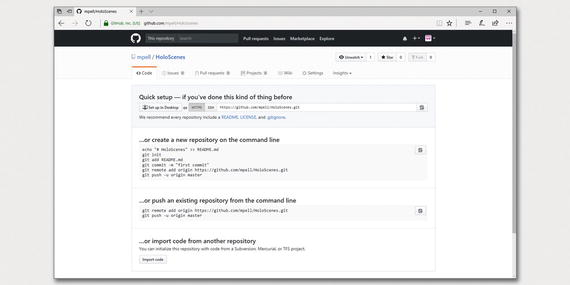
GitHub makes it easy to version control and share your project with other developers
Another benefit of using a service like GitHub is the ability to create your own public profile that details your interests, skills, and recent projects. What a great way to find people who share similar tech interests. Collaboration and sharing are highly encouraged in this type of tool, but you can also protect your projects as private if you need space to explore on your own.
SUPERPOWER – GitHub is the industry’s best practice for keeping code accessible, backed up, and shareable among collaborators. You want to be able to easily rollback or fork branches for new explorations with no fear.
Storytelling Tools
There have always been great tools to help capture the elements of persuasive storytelling. Some of them are quite manual (writing down a narrative on paper, drawing a storyboard, making an animation) and others almost effortless (recording someone’s voice, filming their actions, using a book as reference). In the case of getting down your best storytelling ideas for envisioning purposes, we have a diverse set of tools to rely on. They let us quickly capture the essence of the story so we can convey to other people with too much effort – which it turns out is the most important aspect of all this.
Voice Recorder

Using a smartphone to record your narrative is fast and (mostly) free
There are a gazillion free voice recording apps for just about every kind of smartphone there is, so no reason to not have one ready to record your thoughts whenever the ideas hit you. These apps all allow you to get the recording onto your computer or share with other people.
SUPERPOWER – We love hearing people’s voices telling us engaging stories.
Smartphone Video
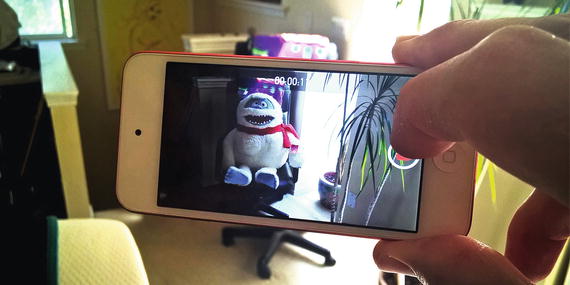
Getting people (or things) to help act out your holographic scenarios isn’t that hard
We are all so familiar with how to share these recorded videos with teammates, collaborators, or prospective audiences, this overly obvious tool should become a very popular way of getting early ideas in front of people.
SUPERPOWER – Video is a super effective way to get the gist of an experience across because you are using real people in physical spaces who can react to direct and ad lib where necessary.
Autodesk SketchBook

Autodesk SketchBook is a great digital storyboarding tool for envisioning
The other important thing about SketchBook is it was designed for the pen. So much better than trying to draw with a mouse! It’s like night and day if you’ve never tried drawing that way. Another key to getting the most out of SketchBook is using the layers just like you would in an Adobe product. It gives you a simple way to draw the background frames, then start layering elements and characters on top, successively. Don’t like what you did? Erase it or just hide that layer. SketchBook Pro is an upgrade that gives you unlimited layers among other amazing features. I’d buy it just for the unlimited layers, they are so fundamental to using the tool.
SUPERPOWER – SketchBook lets you make that deep emotional connection with your story by the nature of it being hand drawn. And it’s a world-class digital sketching tool to boot.
Filmmaker Live

Filmmaker Live is a cinematic tool for storytelling in MR and VR
By taking the perspective of a cinematic production, we not only get a glimpse into that world of filmmaking, but our world of mixed reality design and development takes on a different feel – more along the lines of what a cinematographer may experience as they search for the right camera angles and aesthetic look. It’s a fascinating learning experience and very helpful in thinking about how our participants and onlookers will experience the action.
SUPERPOWER – Filmmaker Live gives us a glimpse into the future of envisioning. By taking the viewpoint of a director on set, we can focus on the cinematic elements of our story – something that’s been more difficult to understand and practice before now.
PowerPoint
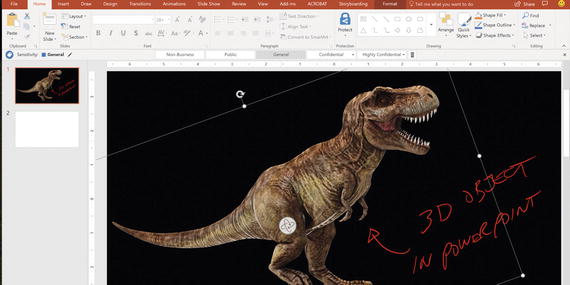
Your story ideas can be animated and annotated quickly in PowerPoint
These programs have the ability to embed images, video, sound, text, ink, links, and true interactivity to create stunningly persuasive stories. The animation capabilities of individual elements or groups is way more sophisticated than most people realize. Dozens of special effects and timings can be applied to slide transitions, clicks or touches, and auto-playing sequences.
And the best part of using this type of presentation tool is the ability for anyone else to edit it easily. The collaborative nature of our work makes PowerPoint an incredibly useful tool to work with.
SUPERPOWER – The ability for anyone to create and share these story ideas makes PowerPoint or other presentation software a great tool choice. The super bonus here is that anyone else can edit the story so easily and send it back, making collaboration simple.
Future Tools
There’s undoubtedly going to be some ultra slick new tools and approaches for building out holographic experiences by the time you read this. My hope is that you are among those who share your best thoughts on how to get from A to B quickly, using unorthodox or even crazy sounding methods to get things done. Be part of the solution for other explorers.
Tools are only as good as the imagination flying them.
